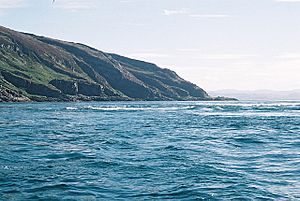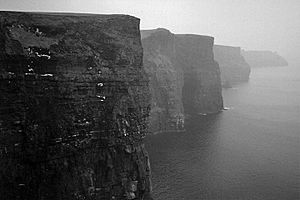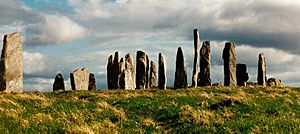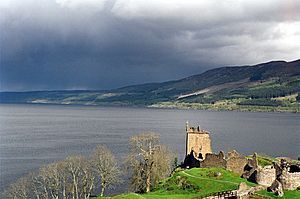Scottish mythology facts for kids
Scottish mythology is a wonderful collection of ancient stories from Scotland. These myths tell us about the beliefs and imagination of people throughout Scottish history. They explain how the world worked, how nature behaved, and feature many brave heroes and mysterious creatures. These tales have been passed down through generations, sometimes changing a little, but always keeping their magic.
Contents
Nature's Powerful Stories

Scottish myths often have a special connection to the land and its seasons. They show us what life was like long ago and how people viewed the wild Scottish landscape. For example, people believed that Beira, the Queen of Winter, controlled the coldest months. She was seen as a strong, old woman who brought storms in January and February. People thought she created the deadly Corryvreckan whirlpool and caused rivers to flood. Even the creation of some lochs (lakes) and mountains was sometimes credited to her!
Unlike some Greek or Roman myths that focus on gods and goddesses, Scottish myths often highlight nature itself. Beira, also known as Cailleach, was the most powerful winter goddess. She ruled until Beltane (a spring festival), when she handed power over to Brighid, who then ruled until Samhain (an autumn festival). This story shows the importance of female power in the cycle of the year. However, some experts like Donald Mackenzie noted that Scottish goddesses were not always glorified in the same way as those in ancient Greece.
Rivers in Scotland were also thought to have their own spirits or goddesses. The nature of the river often matched the spirit. For instance, the River Forth was called the "deaf or soundless river" because of its quiet flow. The River Clyde was known as "the purifying river" because it would clean the land by carrying away mud during floods.
The Ancient Hag, Creator and Protector

Ancient Celtic goddesses were powerful figures. They were often linked to the earth, creation, and the cycle of life. In olden times, the land and its people were sometimes seen as connected to a goddess. A queen might even represent this goddess on Earth. Another important figure in Scottish myths is the "hag," often called the Gaelic Cailleach. This divine being could be both helpful and harmful. The hag was sometimes seen as a "healer" and could even help with childbirth. She was believed to be very old and wise, a creator and a destroyer, gentle and fierce, a mother and a nurturer.
Scotland's Origin Stories
Throughout history, Scots created many stories about where their people came from. These tales helped explain their identity and history.
One old Scottish origin story comes from a Latin text written in the 900s. It tells of settlers from Greek Asia Minor who sailed the seas. They arrived in Ireland and fought with the Pictanei (Picts). After some time, they crossed to Scotland, taking over places like Iona. The land they conquered was then named Scotia, after a legendary Egyptian princess named Scota. This story helped connect the Scots to a grand ancient past.
When the Picts (an ancient people of Scotland) became part of Gaelic culture, their true history slowly faded. Folk tales then filled the gaps. Their "sudden disappearance" was sometimes explained as a trick where they were killed at a feast. People also believed Picts had magical powers, like fairies. They were said to brew heather ale from secret recipes and live in underground homes.
In the Celtic parts of Scotland, known as Gàidhealtachd, you can find very old Neolithic structures. One important ancient site was in the Orkney Isles at the Ness of Brodgar. It had large megalithic stone structures. In northwest Scotland, on the Isle of Lewis, stand the amazing Calanais Stones. These are huge standing stones arranged in a circle with paths leading off them, similar to Stonehenge. Evidence shows these stones are over 5,000 years old. They were likely used for sun worship and lined up with the winter solstice.
Tales of Ulster Heroes
Many heroic stories from ancient Ireland, known as the Ulster Cycle, also became popular in Scotland. This happened because people moved between Ulster (in Ireland) and west Scotland, sharing their language and tales.
The Ulster Cycle stories are set around the beginning of the Christian era. They tell of brave heroes like Cúchulainn and King Conchobar mac Nessa of Ulster. These tales describe a warrior society where fighting was common, and wealth was measured in cattle. Cúchulainn, a super-strong hero, is even said to have learned his fighting skills in Scotland. The most famous story in this cycle is the Táin Bó Cúailnge, about a great cattle raid. These stories are mostly written in prose and feature magic and shape-shifting alongside a realistic view of life.
Finn and the Fianna Warriors
The adventures of Finn and his band of warriors, the Fianna, are another important part of Scottish and Irish mythology. These stories are thought to be set around the 200s AD. Unlike the Ulster Cycle, many of the Fianna tales are told in verse, like long poems. They feel more like romantic adventures than epic battles.
One of the most important sources for these stories is the Acallam na Senórach (Colloquy of the Ancients). It tells of conversations between the last surviving Fianna warriors and Saint Patrick.
Finn's father, Cumhal, was killed by his enemy, Goll mac Morna. Finn grew up in secret. As a young man, he gained amazing wisdom by accidentally burning his thumb while cooking the Salmon of Knowledge. After this, he could gain great insights by sucking his thumb. He became the leader of the Fianna, and many tales tell of their exciting journeys. Two famous stories are The Pursuit of Diarmuid and Gráinne and Oisin in Tír na nÓg. The story of Diarmuid and Gráinne is even thought to be an inspiration for the famous tale of Tristan and Iseult.
The Fianna warriors spent their lives hunting, fighting, and going on adventures, sometimes even in the spirit world. New members had to be good at poetry and pass tough physical tests. These stories focus on the heroes themselves, rather than on gods.
Hebridean Island Legends
The Hebrides, a group of islands off Scotland's west coast, have their own unique myths.
- The Blue Men of the Minch are also called storm kelpies. They live in the waters between the Lewis and mainland Scotland. They are said to look for sailors to drown and boats to sink during storms.
- Kelpies are fabled water-spirits found in Lowland Scotland. They can change their shape, but most often appear as a horse. These water-kelpies are said to haunt lakes and rivers, sometimes trying to drown people. They might even help run mills at night! Kelpies are known for standing by the water's edge, looking calm and friendly. They wait for someone to hop on their back, hoping to cross the water. But once you're on, they might drag you to a watery grave. Kelpies can also appear as beautiful young women to trick young men. A famous story tells of a kelpie who tried to lure ten children to their death. Nine got on its back, but the tenth child touched its nose and his fingers stuck! He bravely cut off his fingers to escape, saving himself and warning the others. Today, in Falkirk, Scotland, two huge horse heads stand 30 meters high. These sculptures represent the Kelpies that watch over Scotland's waters and honor the country's horse-powered industrial past.
- Seonaidh was a Celtic water-spirit that people on Lewis used to worship. They would offer him a glass of ale. One night, the people of Lewis gathered at a church. They brewed ale from malt collected from each family. Then, a chosen person waded into the sea, holding the cup of ale. They offered it to Seonaidh, praying: "I give thee this cup of ale, hoping that thou wilt be so good as to send us plenty of seaware for enriching our ground during the coming year." After the offering, everyone went to the church for a celebration, hoping for good crops.
- A Changeling is a fairy tale creature. It's said that fairies might take a human baby from its crib and leave a fairy baby in its place. This fairy baby often looks like a child but is actually an older fairy.
Orkney and Shetland Island Folklore
The islands of Orkney and Shetland have their own special stories.
- Selkies are amazing creatures that live as seals in the sea. But on land, they can shed their skin and become human! They often do this to dance in the light of the full moon. If a selkie loses its seal skin while in human form, it will be stuck as a human forever. When they are human, they are said to have beautiful green hair. Selkies often live on hidden rocks and islands to stay safe from humans. These legends are very popular in Orkney and Shetland and are similar to stories of swan maidens.
Mysterious Beings and Spirits
Sometimes, myths are part of folklore, which includes all the traditional beliefs and stories of a community. People interested in mythology often focus on non-human or "supernatural" beings. Scotland has many such creatures, some unique to Gaelic or Norse cultures, and others that developed from Scotland's own history.
The Aos-sídhe, or Sìdhichean, often called "Fairies," were originally like the ancient gods and goddesses of Gaelic Scotland before Christianity arrived. As Christianity became more common, these older myths became less powerful. Medieval writers grouped them as the Tuatha Dé Danann, who share traits with other Celtic characters. Folk beliefs about the Banshee also show parts of these ancient spirits. Other supernatural beings include ancestral spirits and giants who were believed to have shaped the landscape.
The Loch Ness Monster
The Loch Ness Monster, affectionately known as "Nessie," is a legendary aquatic creature. Many people have reported seeing it over the years. A popular idea is that Nessie is a lone survivor of the "long-extinct plesiosaurs" – ancient marine reptiles. While sightings were reported as far back as the 500s, more recent reports increased after a road was built around the loch.
One famous sighting was on July 22, 1933, when Mr. and Mrs. Spicer saw the monster on land, about 20 yards from the loch, heading towards the water. In April 1934, a London surgeon took a photograph that became very famous, though its truth has been debated. Even during World War II, in May 1943, C.B. Farrel of the Royal Observer Corps reported a sighting.
Loch Ness is a huge lake, about 22.5 miles (36 kilometers) long and 1.5 miles (2.4 kilometers) wide at its widest point. It's incredibly deep, about 754 feet (230 meters), with a flat bottom. Its volume is the largest of any lake in Great Britain.
The very first recorded sighting of the Loch Ness Monster was in the River Ness in 565 AD. The Irish monk Saint Columba was visiting the Picts when he saw locals burying a man. They explained that a "water beast" had attacked the man while he was swimming, dragging him under. Saint Columba then sent his follower, Luigne moccu Min, to swim across the river. When the beast came after him, Columba made the sign of the cross and commanded: "Go no further. Do not touch the man. Go back at once." The beast immediately stopped as if pulled back by ropes and fled in terror. Everyone, both Columba's men and the Picts, praised God for this miracle.
King Arthur's Scottish Connections
Stories about King Arthur also have links to Scotland. Some Scottish Gaelic songs, like 'Am Bròn Binn' (The Sweet Sorrow), are considered Arthurian ballads. In the legends, Mordred, King Arthur's nephew, was raised in Orkney. Some even think that Camelon in Stirlingshire might have been the original 'Camelot'. There's also a tradition that Arthur had a Scottish son named Smervie More.
See also
- Glenmasan manuscript
- Hebridean Myths and Legends
- Horseman's Word
- Second sight



